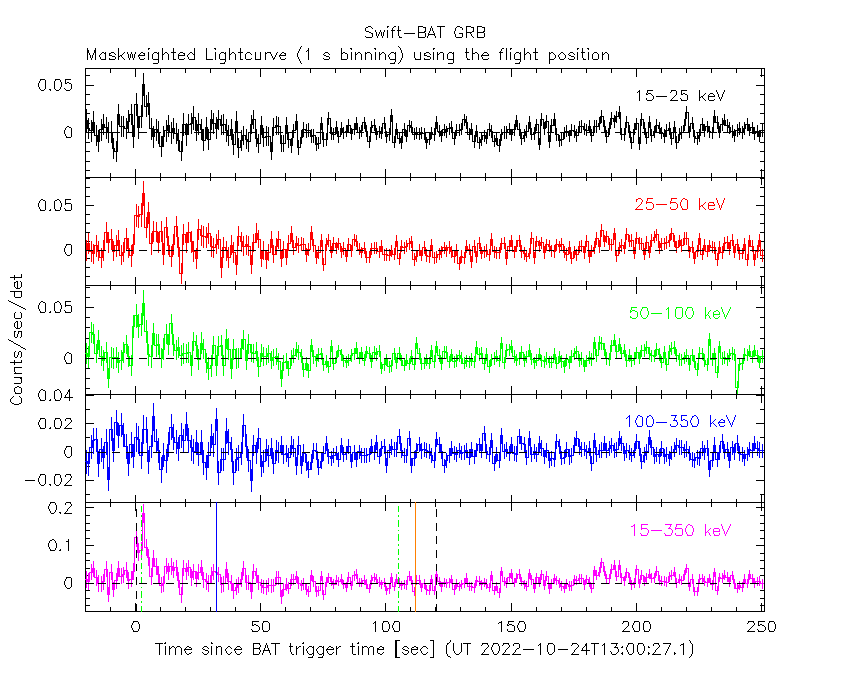
R. Brivio (INAF-OAB), M. Capalbi (INAF-IASFPA) and N.P.M. Kuin () for the Swift team
At 13:00:27 UT, the Swift Burst Alert Telescope (BAT) triggered and located GRB 221024A (trigger=1131029) (Brivio et al. GCN Circ. 32827). Swift slewed immediately to the burst. At the time of the trigger, the initial BAT position was 58° from the Sun (2.6 hours West) and 47° from the 1%-illuminated Moon. Table 1 contains the best reported positions from Swift, and the latest XRT position can be viewed at http://www.swift.ac.uk/xrt_positions.
Swain et al. (GCN Circ. 32841) reported the position from GROWTH-India Tel. for the optical afterglow of this GRB. Table 2 is a summary of GCN Circulars about this GRB from observatories other than Swift.
Standard analysis products for this burst are available at https://gcn.gsfc.nasa.gov/swift_gnd_ana.html.
As reported by Lien et al. (GCN Circ. 32854),
the BAT ground-calculated position is
RA, Dec = 169.702, 33.068 deg which is
RA(J2000) = 1
The mask-weighted light curve (Figure 1) shows a rather weak pulse starting at the trigger
time, peaking around T+5 seconds and decaying to baseline by about T+40 seconds.
There is some low-level emission following this peak, including a possible peak
In the low-energy bands at approximately T+200 seconds.
The pipeline-calculated
The time-averaged spectrum from T+0.00 to T+221.28 s is best fit by a simple
power-law model.
The power law index of the time-averaged spectrum is
1.39 ± 0.25.
The fluence in the 15-150 keV band is 1.5 ± 0.2 x 1
The results of the batgrbproduct analysis are available at https://gcn.gsfc.nasa.gov/notices_s/1131029/BA/.
Analysis of the initial XRT data was reported by Capalbi et al. (GCN Circ. 32846). We have analysed 19 ks of XRT data for GRB 221024A, from 114 s to 236.3 ks after the BAT trigger. The data comprise 248 s in Windowed Timing (WT) mode (the first 8 s were taken while Swift was slewing) with the remainder in Photon Counting (PC) mode. The enhanced XRT position for this burst was given by Osborne et al. (GCN Circ. 32839).
The late-time light curve (Figure 2) (from T0+11.3 ks) can be modelled with a power-law decay with a decay index of α=1.87 ± 0.10.
A spectrum formed from the WT mode data can be fitted with an absorbed power-law with a photon spectral index of 1.53 ± 0.04. The best-fitting absorption column is 5.4 ± 1.1 x 1
A summary of the PC-mode spectrum is thus:
Total column: 6.0 (+3.2, -2.9) x 1
Galactic foreground: 2.9 x 1
Excess significance: 1.7 σ
Photon index: 1.96 (+0.14, -0.13)
The results of the XRT team automatic analysis are available at http://www.swift.ac.uk/xrt_products/01131029.
The Swift/UVOT began settled observations of the field of GRB221024A 127 seconds after the BAT trigger
(Kuin GCN Circ. 32848).
The UVOT could not observe in the u,b,v or white filters due to the nearby bright star nu uMa (V=3.49, U=6.44).
Table 3 gives preliminary
magnitudes using the UVOT photometric system
(Breeveld et al. 2011, AIP Conf. Proc., 1358, 373).
No correction has been made for the expected extinction in the Milky Way
corresponding to a reddening of

Figure 1. The BAT
mask-weighted light curve in the four individual and total
energy bands. The units are counts

Figure 2. The XRT light curve.
Any data from a crosshatched region are not included in the fit.
| RA (J2000) | Dec (J2000) | Error | Note | Reference |
|---|---|---|---|---|
| 1 |
+33°02'31.2" | 2.6" | XRT-final | UKSSDC |
| 1 |
+33°02'31.2" | 2.6" | XRT-enhanced | Osborne et al. GCN Circ. 32839 |
| 1 |
+33°04'04.9" | 2.9' | BAT-refined | Lien et al. GCN Circ. 32854 |
| Band | Authors | GCN Circ. | Subject | Observatory | Notes |
|---|---|---|---|---|---|
| Optical | Strobl et al. | 32838 | D50 candidate afterglow | D50 | detection |
| Optical | Swain et al. | 32841 | GIT confirmation of the optical afterglow |
GROWTH-India Tel. | detection |
| Optical | Andrade et al. | 32859 | GRANDMA observations | GRANDMA | |
| Optical | Belkin et al. | 32863 | Mondy optical observations | Mondy | detection |
Table 3. Found no UVOT observations.
October 28, 2022